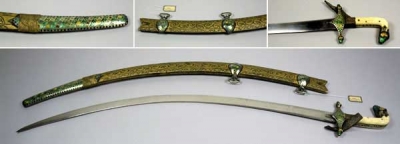Shamshir (1902.87.10)
 IranShamshir from Iran, Asia. Collected by J. B. Elliott. Lent to the Museum by the Bodleian Library in 1902.
IranShamshir from Iran, Asia. Collected by J. B. Elliott. Lent to the Museum by the Bodleian Library in 1902.
Known to Europeans as the scimitar, the shamshir is the quintessential long-sword of the horsemen of Persia (Iran), Moghul India and Arabia. This particular example belongs to a style of the period 1650-1750.
The name means 'tiger's claw', and alludes to its distinctive curve. This curve is a direct functional development, intended to widen the blade's cutting portion and permit deeper wounds when used in a downwards 'drawing' cut. Shamshirs are highly adapted to the horse-mounted form of hand-to-hand combat practised in western and southern Asia between the 16th and 18th centuries, whereby attacks could be made either in passing or by slashing down on infantry from above.
The Art of War
The blades of the best shamshirs were manufactured using wootz, otherwise known as 'True Damascus' steel. This creates a very particular grain on the surface of the blade.
True Damascus blades were manufactured in the Safavid Persian Empire (covering the area of modern Iran and parts of several other countries), originally in Damascus, and then later in Khorassan and Isfahan, using steels of Indian origin. Damascus steel is created by the extremely slow cooling of the melted iron, which encourages the formation of extremely hard Martensite crystals among softer Cementite ones. The veins of these Martensite crystals create the distinctive 'watered steel' pattern on Damascus blades, as well as giving them a fine balance of hardness and flexibility. In the 16th century, Persian 'watered steel' was famous across Eurasia. High quality Persian shamshirs like this one were much sought after since they were capable of splitting contemporary European helmets with a single stroke, and halving a silk handkerchief drawn lightly across their blades. Sadly for this example, over-polishing in the past has all but erased the patterns on it.
This shamshir is of typical Persian form, possessing a down-turned animal-form pommel, delicate langets (metal reinforcement spurs from the hilt, which run part-way down the blade). Also typical is the absence of a ricasso, or khajana, the unsharpened section of the blade near the handle. Shamshirs that do have a ricasso are usually of Indian origin. Similarly, the raised gilt scrollwork on the leather-bound wooden scabbard is a characteristically Persian trait. The acquisition of this Persian shamshir in India is not surprising, as almost all high-status Indians owned swords of Persian manufacture. Animal-shaped pommel terminals, as in this ram-headed example, reflect a high-status and luxurious weapon.
This sword demonstrates a mix of influences in terms of its decoration. In the 14th century, the Sultan of Delhi, Firuz Shah Tughluq, forbade the employment of precious materials in arms during his reign, which laid down a precedent for the use of bone in the shamshir hilts and an altogether more austere Islamic artistic style in north-west India. This led to later luxurious examples possessing ivory hilt cheeks, as seen here. However, equally evident are the later Persian or Mogul preferences for luxury, as shown by the gorgeous green, blue and gold Persian cloisonné enamel on the chape (sheath tip), cross-guard and pommel.





